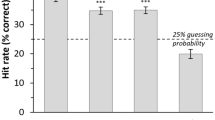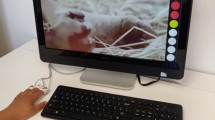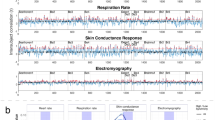Abstract
Objective:
To measure energy expenditure (EE) and heart rate (HR) during genuine laughter.
Design:
Experimental trial of viewing film clips in four cycles either intended to evoke laughter (humorous −10 min) or unlikely to elicit laughter (not humorous −5 min) under strictly controlled conditions of a whole-room indirect calorimeter equipped with audio recording system.
Participants:
Forty five adult friend dyads in either same-sex male (n=7), same-sex female (n=21) and mix-sex male-female (n=17); age 18–34 years; body mass index 24.7±4.9 (range 17.9–41.1).
Measurements:
Energy expenditure in a whole-room indirect calorimeter, HR using Polar HR monitor. Laugh rate, duration and type from digitized audio data using a computerized system and synchronized with HR and EE results.
Results:
Laughter EE was 0.79±1.30 kJ/min (0.19±0.31 kcal/min) higher than resting EE (P<0.001, 95% confidence interval=0.75–0.88 kJ/min), ranging from –2.52 to 9.67 kJ/min (−0.60–2.31 kcal/min). Heart rate during laughter segments increased above resting by 2.1±3.8 beats/min, ranging from −7.6 to 26.8 beats/min. Laughter EE was correlated with HR (rs=0.250, P<0.01). Both laughter EE and HR were positively correlated with laughter duration (rs=0.282 and 0.337, both P<0.001) and rate (rs=0.256 and 0.298, both P<0.001).
Conclusion:
Genuine voiced laughter causes a 10–20% increase in EE and HR above resting values, which means that 10–15 min of laughter per day could increase total EE by 40–170 kJ (10–40 kcal).
This is a preview of subscription content, access via your institution
Access options
Subscribe to this journal
Receive 12 print issues and online access
$259.00 per year
only $21.58 per issue
Buy this article
- Purchase on Springer Link
- Instant access to full article PDF
Prices may be subject to local taxes which are calculated during checkout




Similar content being viewed by others
References
Darwin C . The expression of the emotions in man and animals. In: Ekman P (ed). Introduction, Afterwards, and Commentaries 3rd edn. Harper Collins (US edit. Oxford University Press): New York, 1998.
Ruch W, Ekman P . The expressive pattern of laughter. In: Kaszniak A (ed). Emotion, Qualia and Consciousness. World Scientific: Tokyo, 2001, pp 426–443.
Black DW . Laughter. JAMA 1984; 252: 2995–2998.
Wild B, Rodden FA, Grodd W, Ruch W . Neural correlates of laughter and humour. Brain 2003; 126: 2121–2138.
Martin RA . Humor, laughter, and physical health: methodological issues and research findings. Psychol Bull 2001; 127: 504–519.
Fry W . The physiological effects of humor, mirth, and laughter. JAMA 1992; 267: 1857–1858.
Bennett MP, Zeller JM, Rosenberg L, McCann J . The effect of mirthful laughter on stress and natural killer cell activity. Altern Ther Health Med 2003; 9: 38–45.
Hayashi K, Hayashi T, Iwanaga S, Kawai K, Ishii H, Shoji S et al. Laughter lowered the increase in postprandial blood glucose. Diabetes Care 2003; 26: 1651–1652.
Kimata H . Elevation of breast milk leptin levels by laughter. Horm Metab Res 2004; 36: 254–256.
Clark A, Seidler A, Miller M . Inverse association between sense of humor and coronary heart disease. Intern J Cardiol 2001; 80: 87–88.
Owren MJ, Bachorowski JA . Reconsidering the evolution of nonlinguistic communication: the case of laughter. J Nonverbal Behavior 2003; 27: 183–200.
Sun M, Reed GW, Hill JO . Modification of a whole room indirect calorimeter for measurement of rapid changes in energy expenditure. J Appl Physiol 1994; 76: 2686–2691.
Chen KY, Acra SA, Donahue CL, Sun M, Buchowski MS . Efficiency of walking and stepping: relationship to body fatness. Obes Res 2004; 12: 982–989.
Bachorowski JA, Owren MJ . Sounds of emotion: production and perception of affect-related vocal acoustics. Ann N Y Acad Sci 2003; 1000: 244–265.
Filippelli M, Pellegrino R, Iandelli I, Misuri G, Rodarte JR, Duranti R et al. Respiratory dynamics during laughter. J Appl Physiol 2001; 90: 1441–1446.
Boone T, Hansen S, Erlandson A . Cardiovascular responses to laughter: a inverted question mark pilot project. Appl Nurs Res 2000; 13: 204–208.
Ainsworth BE, Haskell WL, Whitt MC, Irwin ML, Swartz AM, Strath SJ et al. Compendium of physical activities: an update of activity codes and MET intensities. Med Sci Sports Exerc 2000; 9: S498–S516.
Levine JA, Lanningham-Foster LM, McCrady SK, Krizan AC, Olson LR, Kane PH et al. Interindividual variation in posture allocation: possible role in human obesity. Science 2005; 307: 584–586.
Perini R, Veicsteinas A . Heart rate variability and autonomic activity at rest and during exercise in various physiological conditions. Eur J Appl Physiol 2003; 90: 317–325.
Robinson BF, Epstein SE, Beiser GD, Braunwald E . Control of heart rate by the autonomic nervous system. Circ Res 1966; 19: 400–411.
Yamamoto Y, Hughson RL, Peterson JC . Autonomic control of heart rate during exercise studied by heart rate variability spectral analysis. J Appl Physiol 1991; 71: 1136–1142.
Sakuragi S, Sugiyama Y, Takeuchi K . Effects of laughing and weeping on mood and heart rate variability. J Physiol Anthropol Appl Hum Sci 2002; 21: 159–165.
Berk LS, Tan SA, Fry WF, Napier BJ, Lee JW, Hubbard RW et al. Neuroendocrine and stress hormone changes during mirthful laughter. Am J Med Sci 1989; 298: 390–396.
Levenson RW . Autonomic nervous system differences among emotions. Psychol Sci 1992; 3: 23–33.
Provine RP, Fischer KR . Laughing, smiling, and talking: relation to sleeping and social context in humans. Ethology 1989; 83: 295–305.
Muller MJ, Bosy-Westphal A, Kutzner D, Heller M . Metabolically active components of fat-free mass and resting energy expenditure in humans: recent lessons from imaging technologies. Obes Rev 2002; 3: 113–122.
Acknowledgements
This study was supported partly by the US National Institutes of Health (HBL 001750) to MSB, General Clinical Research Center Grant RR-00095 (to Vanderbilt University) and Clinical Nutrition Research Unit Grant DK-26657 (to Vanderbilt University).
Author information
Authors and Affiliations
Corresponding author
Rights and permissions
About this article
Cite this article
Buchowski, M., Majchrzak, K., Blomquist, K. et al. Energy expenditure of genuine laughter. Int J Obes 31, 131–137 (2007). https://doi.org/10.1038/sj.ijo.0803353
Received:
Revised:
Accepted:
Published:
Issue Date:
DOI: https://doi.org/10.1038/sj.ijo.0803353



